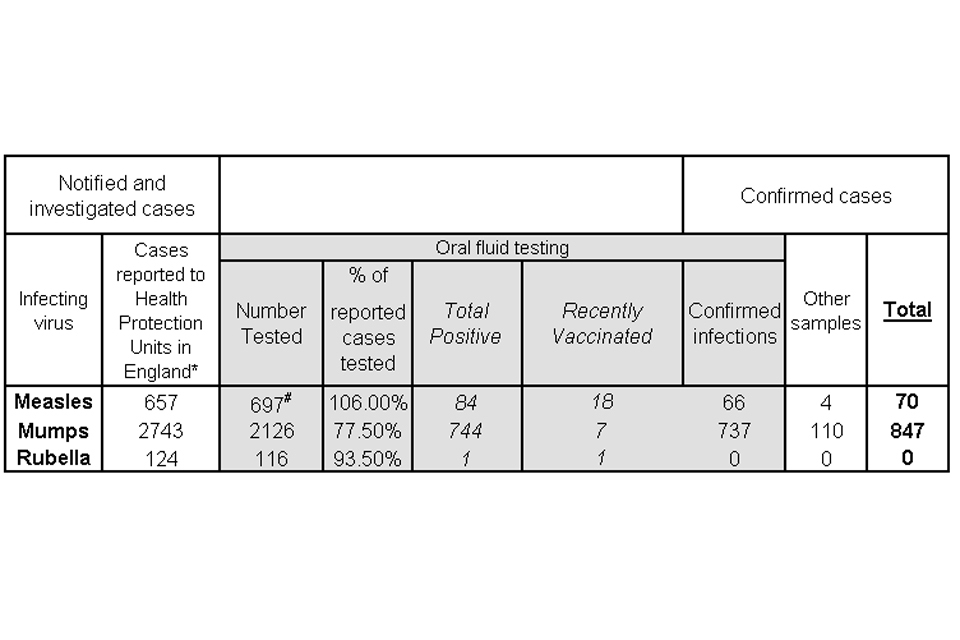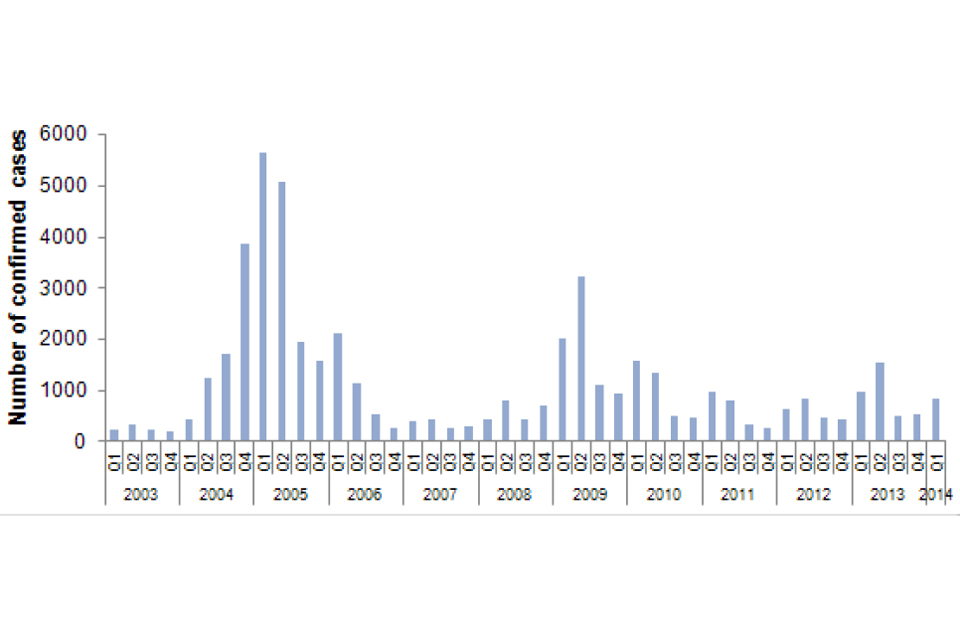Laboratory confirmed cases of measles, mumps and rubella, England: January to March 2014
Updated 27 February 2015
Data presented here are for the first quarter of 2014 (ie January to March). Cases include those confirmed by oral fluid testing (IgM antibody tests and/or PCR) at the Virus Reference Department, Colindale and national routine laboratory reports (mumps infections only) (table 1). Analyses are by date of onset and regional breakdown figures relate to Government Office Regions.
Quarterly figures for cases confirmed by oral fluid antibody detection only from 1995 and annual total numbers of confirmed cases by region and age are available from:
- http://www.hpa.org.uk/web/HPAweb&HPAwebStandard/HPAweb_C/1195733778332
- http://www.hpa.org.uk/web/HPAweb&HPAwebStandard/HPAweb_C/1195733841496
- http://www.hpa.org.uk/web/HPAweb&HPAwebStandard/HPAweb_C/1195733752351
0.1 Table 1. Laboratory-confirmed cases of measles, mumps and rubella and oral fluid IgM antibody tests in notified cases: weeks 1 to 13, 2014

Table 1. Laboratory-confirmed cases of measles, mumps and rubella and oral fluid IgM antibody tests in notified cases: weeks 1 to 13, 2014
* This represents the number of infections reported as possible cases and investigated by individual PHE centres in England
# Some cases may have been notified late
1. Measles
Seventy measles infections were confirmed in England between the beginning of the year and end of March, an increase on the 24 cases of measles observed between October and December 2013 [1].
More than 40% of the cases in the current quarter were reported from London (30 cases), although all regions reported cases. Across the UK, an additional 18 infections were confirmed by oral fluid testing, 16 from Wales and one each from Scotland and Isle of Man.
The majority (41/70, 59%) of the English measles cases this quarter were in children and adolescents: 12 (17%) under one year; 18 (26%) aged one to four years; five (7%) aged five to nine year, three (4%) aged 10 to 14 years; three (4%) aged 15 to 18 years. The remaining 29 adult cases (41%) were aged 19 to 53 years. Three cases reported receiving one dose and four cases reported receiving two doses of a measles-containing vaccine.
Twenty-seven (39%) of the cases reported in the period reported a history of recent travel; 16 to Philippines, six to India and one each to Dubai, Spain, Thailand, France and Australia [2].
In 2013, 10,271 cases were reported within the European Union and European Economic Area (EU/EEA) with the majority (91%) of cases reported from five countries (including the UK). The number of cases observed in 2013 remains low compared to the epidemic years 2010 and 2011, however, eight cases were complicated by acute measles encephalitis, and there were three deaths. WHO has published the framework for the verification process of the measles and rubella elimination in the WHO European region [3].
2. Mumps
There were 847 laboratory confirmed cases of mumps with onset in the first quarter of 2014, compared to the 520 cases reported in the last quarter of 2013. This follows the trend observed over the last decade of an increase in cases in first quarter of the year compared to the previous quarter (see figure) [1]. Cases continue to be identified predominantly in young adults between 15 and 30 years of age (664/847 78%, table 2). Nearly 40% of all cases this quarter have received at least one dose of MMR vaccination in childhood, suggesting that some waning immunity may be contributing to transmission. Mumps cases were identified in all regions of England although half of all cases were identified in London, the South East and the South West regions (table 2).
2.1 Table 2: Laboratory confirmed cases of mumps by age group and region, England: weeks 1 to 13, 2014
| Region | <1 | 1-4 | 5-9 | 10-14 | 15-19 | 20-24 | 25+ | Total |
|---|---|---|---|---|---|---|---|---|
| North East | 0 | 1 | 0 | 0 | 6 | 9 | 8 | 24 |
| North West | 0 | 2 | 3 | 3 | 22 | 29 | 34 | 93 |
| Yorkshire and the Humber | 0 | 1 | 1 | 5 | 13 | 21 | 27 | 68 |
| East Midlands | 0 | 1 | 0 | 1 | 32 | 15 | 8 | 57 |
| West Midlands | 0 | 1 | 0 | 2 | 23 | 46 | 41 | 113 |
| East of England | 0 | 2 | 3 | 8 | 25 | 17 | 15 | 70 |
| London | 0 | 1 | 5 | 6 | 36 | 45 | 66 | 159 |
| South East | 0 | 1 | 2 | 7 | 44 | 39 | 41 | 134 |
| South West | 0 | 2 | 0 | 13 | 36 | 45 | 33 | 129 |
| Total | 0 | 12 | 14 | 45 | 237 | 266 | 273 | 847 |
The figure shows that the level of mumps confirmed in this quarter is similar to that reported in the first quarter of non-peak years since 2003. With the exception of 2004, the number of cases reported in the second half of each year has been lower than in the first half.

Laboratory confirmed cases of mumps by quarter, England, 2003 to 2014
3. Rubella
No cases of rubella were confirmed in the reporting quarter compared to three cases identified in the last quarter of 2013 [1].
Countries within the EU/EEA with established rubella surveillance identified very few rubella infections. Poland was the only country with an ongoing outbreak, reporting 99% of the 38,847 clinical rubella cases in 2013, however none of these were laboratory confirmed [4].
4. References
- PHE (2014). Laboratory confirmed cases of measles, mumps and rubella, England and Wales: October to December 2013. HPR 8 (8): immunisation.
- PHE (2014). UK measles cases in travellers returning from the Philippines. HPR 8 (5): news.
- World Health Organisation (2014). Eliminating measles and rubella: framework for the verification process in the WHO European Region.
- European Centre for Disease Prevention and Control (2014). Surveillance report: Measles and rubella monitoring: February 2014
This report was published in Health Protection Report volume 8 issue 20.
